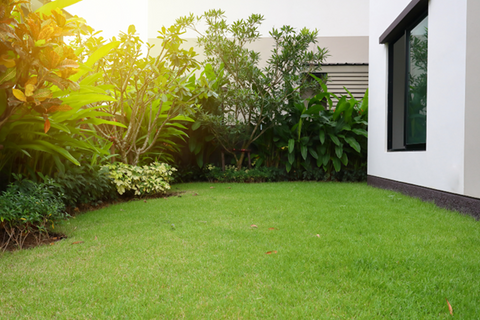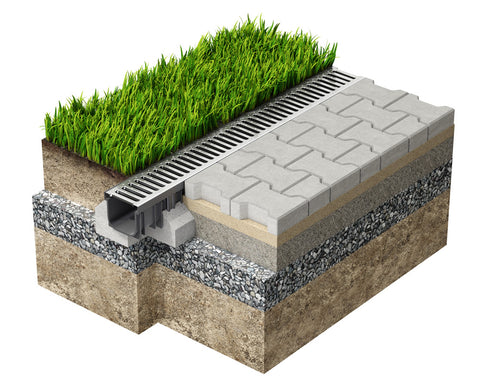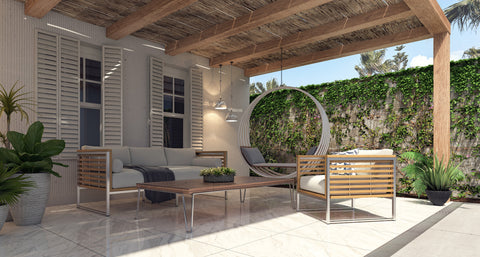The impact of drainage on maintaining a healthy garden and lawn or landscape cannot be understated. Learn the benefits of drainage on this blog page.
Not only do most plants, including vegetables, fruits, and flowers, need well-drained soil to grow properly, but proper drainage also helps prevent standing water, which can attract unwanted pests and lead to potential disease in plants.
What's more, proper drainage not only promotes a healthy and thriving garden but also helps prevent costly damage to your property.
For many homeowners, their garden’s drainage issues are out of sight, out of mind until it becomes a problem and they are left scrambling for solutions.
Standing water can lead to flooded gardens and lawns, as well as potentially cause damage to foundations, driveways, and walkways. So, if you've been Googling "how to fix drainage issue in yard?" fear not! We have some tried and true solutions for you.
The Benefits of Drainage

There are many important benefits of having well-drained soil in your garden, including:
- Allowing oxygen to reach plant roots - Oxygen is essential for the root systems of most plants. Without it, roots cannot properly absorb nutrients from the soil. Waterlogged soil prevents oxygen from reaching plant roots, which can lead to stunted growth or even death.
- Preventing root rot - When plant roots are constantly saturated with water, they are susceptible to root rot. Root rot is a condition caused by waterlogged soils that leads to the decomposition of plant roots. This can eventually kill the plant.
- Encourages beneficial microorganisms - Microorganisms, such as worms and bacteria, play a vital role in maintaining healthy soil. Well-drained soil allows these organisms to thrive, resulting in improved soil structure and fertility.
- Enhances your soil's overall health - Drainage helps to prevent many issues that can harm your soil, such as compaction and erosion.
- Protecting your home from damage - Poor landscape drainage can lead to water build-up near the foundation of your home, potentially causing costly damage. A properly installed drainage system can redirect excess water away from your home and protect its foundation.
How to Fix Landscape Drainage Issues in Your Yard

If you notice standing water or soggy areas in your garden, there are steps you can take to improve drainage. Here are the most effective solutions:
- Install a French drain - A French drain, also known as "ag pipe", is a trench filled with gravel or rocks that redirects water away from problem areas in your garden. The Atlantis Flo-Log from Atlantis Corporation is a great option for DIY installation and its modular design allows for easy customisation to fit your unique drainage needs.
- Improve surface drainage - Constructing a system of parallel, shallow ditches (known as swale drains) allows for water to flow away from problem areas. Adding mulch or soil can also help improve surface drainage.
- Upgrade your home's gutter and downspout system - Gutters and downspouts that are not functioning correctly can lead to water build-up in your garden. Ensuring they are properly connected and free of debris is key for proper drainage. A guttering system that gathers rainwater and sends it directly to the ground will help stop a drainage problem from becoming worse.
- Use strip drains - Also called ‘linear drains’, strip drains are installed along low-lying areas, such as at the base of a retaining wall or along a driveway, to redirect water away from those areas, helping to ensure proper landscape drainage. Browse our range of Linear Drains Today!
- Install drainage cell - Drainage cell, also called a drain field or dry well, is a permeable underground structure that collects and stores excess water, allowing it to gradually seep into the ground. This is an ideal option for draining planter boxes as it helps prevent waterlogging and root rot. Check out the Atlantis Flo-Cell.
How to detect drainage issues
There are several signs that can indicate drainage issues in your garden, including:
- Standing water or wet, soggy patches of soil
- Erosion or bare patches in your lawn
- Pooling water near the foundation of your home
If you notice any of these red flags, it is important to address the issue as soon as possible to prevent further damage.
Final thoughts

Proper drainage is crucial for a healthy and thriving garden. By taking steps to fix drainage issues, you can not only improve the health of your plants and soil, but also protect your property from potential damage.
It is important to regularly inspect your garden for any signs of drainage issues and take action as necessary. Understanding how to fix landscape drainage issues can ensure a beautiful and well-maintained garden for years to come.
At The Landscape Store, we understand that what goes into maintaining and improving your landscape goes beyond just planting flowers and trees. You also have to consider unseen but vital elements, such as drainage and soil health. That's why our team is dedicated to helping you create and maintain a beautiful and healthy garden through proper drainage solutions.
We offer a range of drainage solutions, from French drains to strip drains, to ensure proper drainage in your garden. Fixing drainage issues can mean the difference between a struggling garden and a flourishing oasis. Why not pop into our Artamon store or visit us online today to learn more about our drainage solutions and how we can help improve the overall look and health of your garden?

